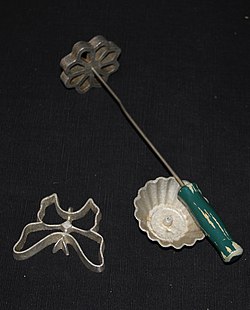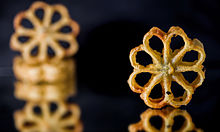Rosette (cookie)
 From Wikipedia - Reading time: 9 min
From Wikipedia - Reading time: 9 min
 Sugared rosettes from a bakery | |
| Type | Fritter |
|---|---|
| Course | Snack, dessert |
| Main ingredients | Batter (wheat flour, milk, sugar, salt, eggs) |
| Variations | Timbale, Kembang goyang |

Rosette are thin, cookie-like fritters made with iron molds that are found in many cultures. They are crispy and characterized by their lacy pattern.
Preparation
[edit]The batter is a blend of wheat flour, eggs, sugar and whole milk. Rosette cookies are formed with a rosette iron. This specialized tool has a long handle and with a metal shape, commonly stars, flowers, snowflakes or Christmas trees.[1][2] In Kerala, India, Rosette cookies known as Achappam are made using rice flour.
The metal is heated in hot oil before it is dipped in batter. Returning the iron to the oil, the batter is detached from the mold when it is partially cooked and gently flipped to finish cooking. They are usually topped with sugar or honey,[3] or the edges of rosettes are dipped into frosting.[4][5] The process was recorded in the 19th century Ottoman cookbook Aşçı başı.
Swedish timbale can be made with rosette batter using a timbale mold instead of an iron. These can be made with savory fillings like creamed chicken and mushrooms.[6]
Geographic distribution
[edit]
Versions of this cookie exist in places such as northern Europe, Iran, Turkey, and Sri Lanka.[3]
This type of fritter exists in Nordic countries known as:
- Denmark: rosetbakkelse
- Finland: rosetti[citation needed]
- Norway: rosettbakkels; rosetter[3]
- Swedish: struvor
Rosette recipes are popular in the United States among families with Scandinavian ancestry.[7]
In Alentejo (Portugal), they are known as filhós de forma (lit. 'formed donuts') or filhós de floreta (lit. 'flower donuts') are popular at Christmas.[8] The batter is flavored with port and orange juice.[9]
- Spain: flores manchegas (lit. 'La Mancha flowers')
- Mexico: buñuelos de viento (lit. 'wind fritters')[10]
In the Middle East and western Asia:
- Afghanistan: kulcha-e-panjerei (lit. 'window biscuits')
- Iran: shirini panjerei (شیرینی پنجرهای)
- Turkey: demir tatlisi
- Tunisia: chebbak el-janna
They are typical of Anglo-Indian cuisine and a favourite among Indian Christians during the Christmas season introduced by the Dutch in the 1600s.[11] They are called rose cookies or rose biscuits in Indian-English.[12][13] In India, they are made from flour, sugar, eggs and coconut milk:[citation needed]
- Bangladesh: fuljhuri pitha, fulkuchi pitha
- Kerala: achappam[14]
- Malayalam: achappam
- Odisha: mahughara khaja
- Sri Lanka: kokis[3]
- Tamil: acchu murukku
- Telugu: gulabi puvvulu
In Cantonese they are known as tong wan. It was introduced to Hawaii, where they are known as Chinese pretzels.[15][16][17] In Malaysia, they are known as kuih Loyang.[18]
See also
[edit]![]() Media related to Rosettes (food) at Wikimedia Commons
Media related to Rosettes (food) at Wikimedia Commons
- List of fried dough foods
- List of Christmas dishes
- Christmas cookie
- Norwegian cuisine
- Swedish cuisine
References
[edit]- ^ 10 Traditional Christmas Sweet Recipe Retrieved 30 November 2013
- ^ Good ol’ Christmas Retrieved 30 November 2013
- ^ a b c d The Oxford Companion to Sugar and Sweets. Oxford University Press. April 2015. ISBN 978-0-19-931362-4.
- ^ Kari Diehl (26 January 2019). "How to Make Scandinavian Rosette Cookies". thespruceeats.com. Retrieved 1 March 2020.
- ^ "How to Make Rosettes Cookies". thatskinnychickcanbake. Retrieved 1 March 2020.
- ^ The Delta Cook Book: A Collection of Tested Recipes, Recommended by Experienced Housekeepers. First Methodist Church Ladie's Aid Society. 1917. p. 24.
- ^ "Rosetter (rosettbakkelse)". tine.no. Retrieved 1 March 2020.
- ^ Magalhães, Márcio (12 November 2022). "Receitas de filhós tradicionais, ou filhoses de Natal. Uma delícia!". NCultura (in European Portuguese). Retrieved 6 November 2023.
- ^ Fernandes, Daniel. "Filhós de Forma". Produtos Tradicionais Portugueses (in Portuguese). Direção-Geral de Agricultura e Desenvolvimento Rural. Retrieved 6 November 2023.
- ^ Flores, Maricruz Avalos (4 November 2023). "Buñuelos de Viento (Mexican Rosette Fritters)". M.A. Kitchen. Retrieved 6 November 2023.
- ^ Cherian, Kaviya (18 August 2023). "The Rose Cookie Through the Lens of Colonialism". Whetstone Magazine. Retrieved 6 November 2023.
- ^ Bear, Laura (2007). Lines of the Nation: Indian Railway Workers, Bureaucracy, and the Intimate Historical Self. ISBN 9780231140027.
- ^ Carsten, Janet (15 April 2008). Ghosts of Memory: Essays on Remembrance and Relatedness. ISBN 9780470691540.
- ^ Experiencing the true spirit of Xmas in Kerala Retrieved 30 November 2013
- ^ "Yum Yum Cha: Let's Eat Dim Sum in Hawaii – Staradvertiser". Honolulu Star-Advertiser. Retrieved 6 November 2023.
- ^ Miura, Muriel; Tom, Lynette Lo (2021). Yum Yum Cha: Let’s Eat Dim Sum in Hawaii. Honolulu: Honolulu Star-Advertiser. ISBN 978-1-949307-29-0.
- ^ Linn, Nancy. "CHINESE PRETZELS (TONG WAN)". www.hawaii.edu. Retrieved 6 November 2023.
- ^ A rosy sweet for Christmas "Rose Cookies" by Esme Stephens Retrieved 30 November 2013
Related reading
[edit]- Astrid Karlsen Scott (2000) Authentic Norwegian Cooking (Nordic Adventures). ISBN 978-0963433978.
- Jan Hedh (2012) Swedish Cookies, Tarts, and Pies (Skyhorse). ISBN 978-1616088262.
 KSF
KSF